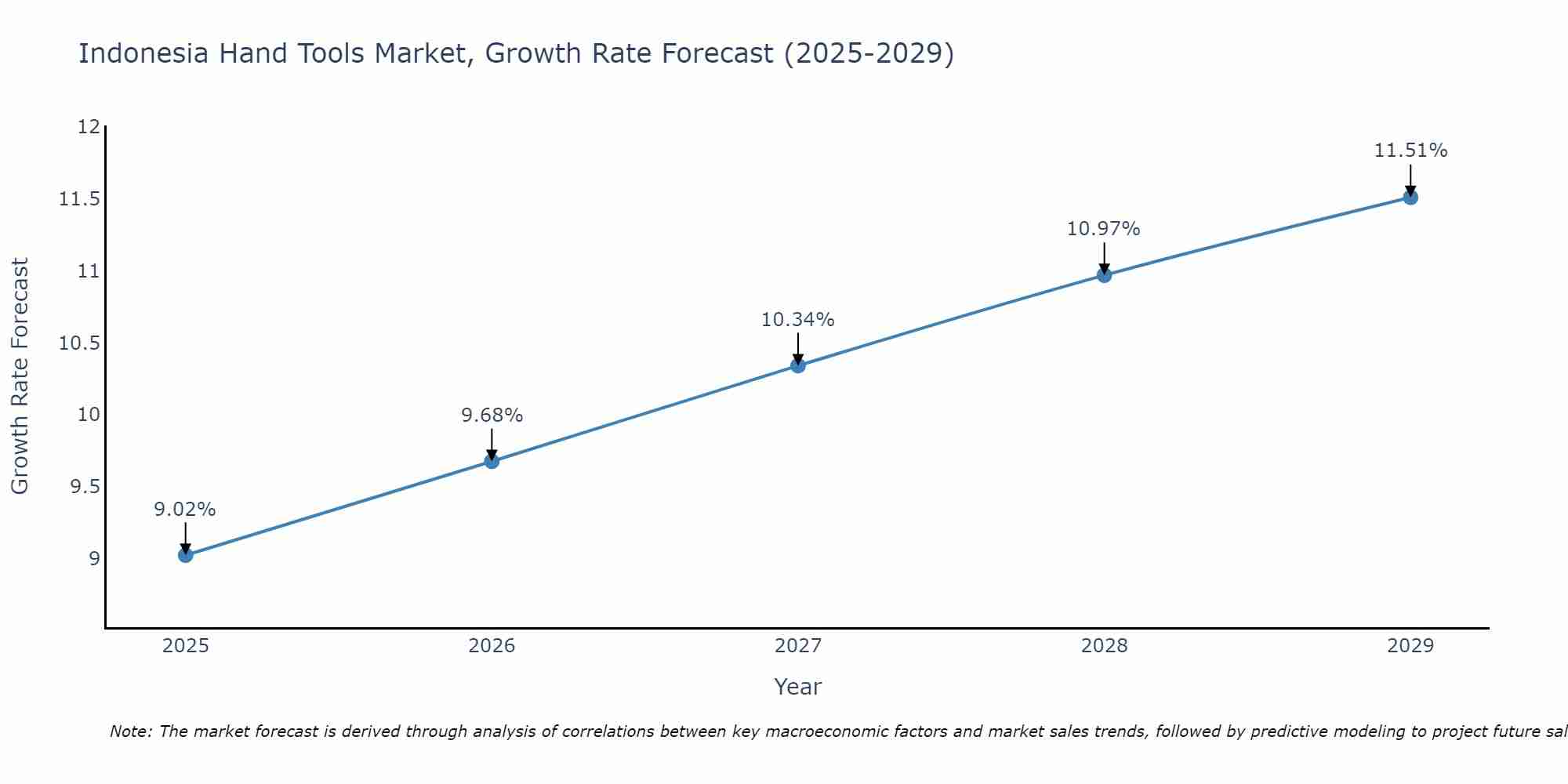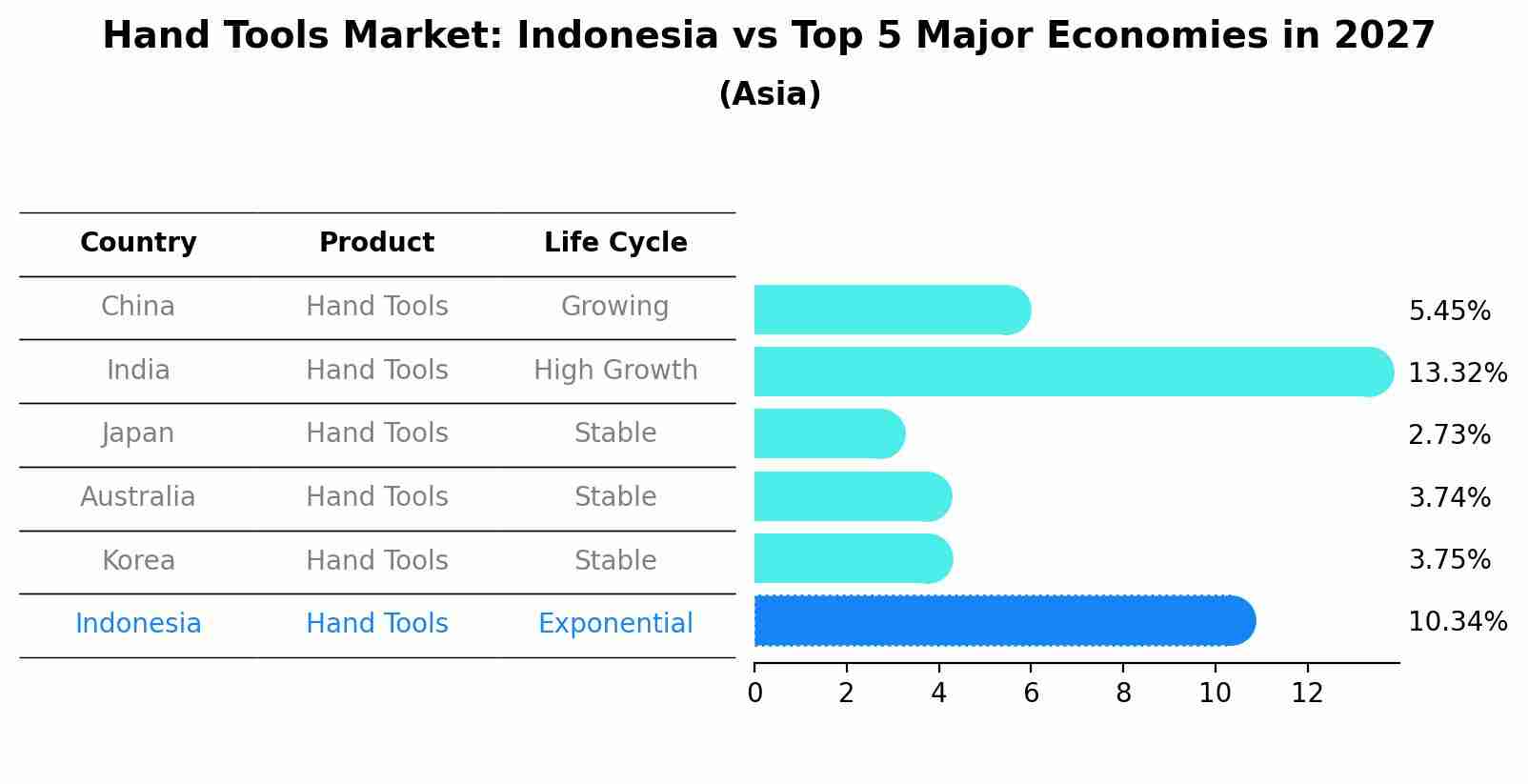Indonesia Hand Tools Market (2025-2031) Outlook | Industry, Analysis, Size, Share, Growth, Trends, Companies, Value, Revenue & Forecast
| Product Code: ETC327448 | Publication Date: Aug 2022 | Updated Date: Aug 2025 | Product Type: Market Research Report | |
| Publisher: 6Wresearch | Author: Ravi Bhandari | No. of Pages: 75 | No. of Figures: 35 | No. of Tables: 20 |
Indonesia Hand Tools Market Size Growth Rate
The Indonesia Hand Tools Market is likely to experience consistent growth rate gains over the period 2025 to 2029. From 9.02% in 2025, the growth rate steadily ascends to 11.51% in 2029.

Hand Tools Market: Indonesia vs Top 5 Major Economies in 2027 (Asia)
In the Asia region, the Hand Tools market in Indonesia is projected to expand at a high growth rate of 10.34% by 2027. The largest economy is China, followed by India, Japan, Australia and South Korea.

Indonesia Hand Tools Market Synopsis
The Indonesia Hand Tools Market stands at an estimated USD 449 Million in 2025 growing at a CAGR (Compound Annual Growth Rate) of 7.1% during forecast period owing to increased construction activities across both residential as well as commercial sectors. Electric tools form majority chunk i.e 70% followed by non electric hand tools that together contribute 90% of overall sales volume while specialty tools account balance 10 % Some popular global companies operating in this sector include Stanley, Bosch, DeWalt, Makita amongst others while local players like Prambanan Mitra Abadi take up significant share too. Increasing awareness about health & safety protocols coupled with technological advancements like cordless power tool range will propel further industry`s growth.
Drivers of the Market
The Indonesia Hand Tools market is driven by construction and DIY activities, infrastructure development, and the growth of maintenance and repair services. Hand tools are essential for tasks such as carpentry, plumbing, electrical work, and general repairs. As construction projects and home improvement ventures increase, the demand for quality hand tools grows. Moreover, the emergence of small-scale businesses and the prevalence of artisanal craftsmanship contribute to the market`s expansion. The convenience and versatility of hand tools make them indispensable across various industries, sustaining the market`s upward trajectory.
Challenges of the Market
Challenges in the Indonesia Hand Tools market include competition from power tools and mechanized alternatives. Ensuring product durability, quality, and safety standards while maintaining affordability can be demanding. Adapting to changing technology and consumer preferences while retaining the traditional appeal of hand tools is a challenge faced by manufacturers.
COVID-19 Impact on the Market
The Indonesia Hand Tools market faced supply chain disruptions during the pandemic, impacting manufacturing and distribution. Lockdowns and reduced construction activities affected demand from industries such as construction and manufacturing. However, with the gradual reopening of businesses and a focus on DIY projects, the market began to recover as consumers sought tools for home improvement.
Key Players in the Market
In the Indonesia Hand Tools market, major players include PT Modern Internasional Tbk, known for its comprehensive range of hand tools and hardware products, and PT Krisbow Indonesia, a company that offers a variety of tools and equipment for both professional and DIY use.
Key Highlights of the Report:
- Indonesia Hand Tools Market Outlook
- Market Size of Indonesia Hand Tools Market, 2024
- Forecast of Indonesia Hand Tools Market, 2031
- Historical Data and Forecast of Indonesia Hand Tools Revenues & Volume for the Period 2021-2031
- Indonesia Hand Tools Market Trend Evolution
- Indonesia Hand Tools Market Drivers and Challenges
- Indonesia Hand Tools Price Trends
- Indonesia Hand Tools Porter's Five Forces
- Indonesia Hand Tools Industry Life Cycle
- Historical Data and Forecast of Indonesia Hand Tools Market Revenues & Volume By Type for the Period 2021-2031
- Historical Data and Forecast of Indonesia Hand Tools Market Revenues & Volume By Wrench for the Period 2021-2031
- Historical Data and Forecast of Indonesia Hand Tools Market Revenues & Volume By Plier for the Period 2021-2031
- Historical Data and Forecast of Indonesia Hand Tools Market Revenues & Volume By Screw Drivers for the Period 2021-2031
- Historical Data and Forecast of Indonesia Hand Tools Market Revenues & Volume By Hammers for the Period 2021-2031
- Historical Data and Forecast of Indonesia Hand Tools Market Revenues & Volume By Cable Cutter for the Period 2021-2031
- Historical Data and Forecast of Indonesia Hand Tools Market Revenues & Volume By Others for the Period 2021-2031
- Historical Data and Forecast of Indonesia Hand Tools Market Revenues & Volume By Distribution Channel for the Period 2021-2031
- Historical Data and Forecast of Indonesia Hand Tools Market Revenues & Volume By In Store for the Period 2021-2031
- Historical Data and Forecast of Indonesia Hand Tools Market Revenues & Volume By Online for the Period 2021-2031
- Historical Data and Forecast of Indonesia Hand Tools Market Revenues & Volume By End User for the Period 2021-2031
- Historical Data and Forecast of Indonesia Hand Tools Market Revenues & Volume By Diy for the Period 2021-2031
- Historical Data and Forecast of Indonesia Hand Tools Market Revenues & Volume By Commercial for the Period 2021-2031
- Historical Data and Forecast of Indonesia Hand Tools Market Revenues & Volume By Industrial for the Period 2021-2031
- Indonesia Hand Tools Import Export Trade Statistics
- Market Opportunity Assessment By Type
- Market Opportunity Assessment By Distribution Channel
- Market Opportunity Assessment By End User
- Indonesia Hand Tools Top Companies Market Share
- Indonesia Hand Tools Competitive Benchmarking By Technical and Operational Parameters
- Indonesia Hand Tools Company Profiles
- Indonesia Hand Tools Key Strategic Recommendations
Frequently Asked Questions About the Market Study (FAQs):
1 Executive Summary |
2 Introduction |
2.1 Key Highlights of the Report |
2.2 Report Description |
2.3 Market Scope & Segmentation |
2.4 Research Methodology |
2.5 Assumptions |
3 Indonesia Hand Tools Market Overview |
3.1 Indonesia Country Macro Economic Indicators |
3.2 Indonesia Hand Tools Market Revenues & Volume, 2021 & 2031F |
3.3 Indonesia Hand Tools Market - Industry Life Cycle |
3.4 Indonesia Hand Tools Market - Porter's Five Forces |
3.5 Indonesia Hand Tools Market Revenues & Volume Share, By Type, 2021 & 2031F |
3.6 Indonesia Hand Tools Market Revenues & Volume Share, By Distribution Channel, 2021 & 2031F |
3.7 Indonesia Hand Tools Market Revenues & Volume Share, By End User, 2021 & 2031F |
4 Indonesia Hand Tools Market Dynamics |
4.1 Impact Analysis |
4.2 Market Drivers |
4.2.1 Growth in the construction industry in Indonesia leading to increased demand for hand tools |
4.2.2 Rising DIY (Do-It-Yourself) trend among consumers driving sales of hand tools |
4.2.3 Government initiatives to promote infrastructure development boosting the market for hand tools |
4.3 Market Restraints |
4.3.1 Competition from cheaper imported hand tools affecting local manufacturers |
4.3.2 Fluctuations in raw material prices impacting production costs |
4.3.3 Lack of skilled labor for manufacturing high-quality hand tools affecting supply chain |
5 Indonesia Hand Tools Market Trends |
6 Indonesia Hand Tools Market, By Types |
6.1 Indonesia Hand Tools Market, By Type |
6.1.1 Overview and Analysis |
6.1.2 Indonesia Hand Tools Market Revenues & Volume, By Type, 2021-2031F |
6.1.3 Indonesia Hand Tools Market Revenues & Volume, By Wrench, 2021-2031F |
6.1.4 Indonesia Hand Tools Market Revenues & Volume, By Plier, 2021-2031F |
6.1.5 Indonesia Hand Tools Market Revenues & Volume, By Screw Drivers, 2021-2031F |
6.1.6 Indonesia Hand Tools Market Revenues & Volume, By Hammers, 2021-2031F |
6.1.7 Indonesia Hand Tools Market Revenues & Volume, By Cable Cutter, 2021-2031F |
6.1.8 Indonesia Hand Tools Market Revenues & Volume, By Others, 2021-2031F |
6.2 Indonesia Hand Tools Market, By Distribution Channel |
6.2.1 Overview and Analysis |
6.2.2 Indonesia Hand Tools Market Revenues & Volume, By In Store, 2021-2031F |
6.2.3 Indonesia Hand Tools Market Revenues & Volume, By Online, 2021-2031F |
6.3 Indonesia Hand Tools Market, By End User |
6.3.1 Overview and Analysis |
6.3.2 Indonesia Hand Tools Market Revenues & Volume, By Diy, 2021-2031F |
6.3.3 Indonesia Hand Tools Market Revenues & Volume, By Commercial, 2021-2031F |
6.3.4 Indonesia Hand Tools Market Revenues & Volume, By Industrial, 2021-2031F |
7 Indonesia Hand Tools Market Import-Export Trade Statistics |
7.1 Indonesia Hand Tools Market Export to Major Countries |
7.2 Indonesia Hand Tools Market Imports from Major Countries |
8 Indonesia Hand Tools Market Key Performance Indicators |
8.1 Number of new construction projects initiated in Indonesia |
8.2 Consumer engagement with DIY tutorials and workshops |
8.3 Government spending on infrastructure development projects |
8.4 Percentage of locally manufactured hand tools in the market |
8.5 Skill development programs for hand tool manufacturing industry |
9 Indonesia Hand Tools Market - Opportunity Assessment |
9.1 Indonesia Hand Tools Market Opportunity Assessment, By Type, 2021 & 2031F |
9.2 Indonesia Hand Tools Market Opportunity Assessment, By Distribution Channel, 2021 & 2031F |
9.3 Indonesia Hand Tools Market Opportunity Assessment, By End User, 2021 & 2031F |
10 Indonesia Hand Tools Market - Competitive Landscape |
10.1 Indonesia Hand Tools Market Revenue Share, By Companies, 2024 |
10.2 Indonesia Hand Tools Market Competitive Benchmarking, By Operating and Technical Parameters |
11 Company Profiles |
12 Recommendations |
13 Disclaimer |
- Single User License$ 1,995
- Department License$ 2,400
- Site License$ 3,120
- Global License$ 3,795
Search
Thought Leadership and Analyst Meet
Our Clients
Related Reports
- Germany Breakfast Food Market (2026-2032) | Industry, Share, Growth, Size, Companies, Value, Analysis, Revenue, Trends, Forecast & Outlook
- Australia Briquette Market (2025-2031) | Growth, Size, Revenue, Forecast, Analysis, Trends, Value, Share, Industry & Companies
- Vietnam System Integrator Market (2025-2031) | Size, Companies, Analysis, Industry, Value, Forecast, Growth, Trends, Revenue & Share
- ASEAN and Thailand Brain Health Supplements Market (2025-2031) | Strategy, Consumer Insights, Analysis, Investment Trends, Opportunities, Growth, Size, Share, Industry, Revenue, Segments, Value, Segmentation, Supply, Forecast, Restraints, Outlook, Competition, Drivers, Trends, Demand, Pricing Analysis, Competitive, Strategic Insights, Companies, Challenges
- ASEAN Bearings Market (2025-2031) | Strategy, Consumer Insights, Analysis, Investment Trends, Opportunities, Growth, Size, Share, Industry, Revenue, Segments, Value, Segmentation, Supply, Forecast, Restraints, Outlook, Competition, Drivers, Trends, Demand, Pricing Analysis, Competitive, Strategic Insights, Companies, Challenges
- Europe Flooring Market (2025-2031) | Outlook, Share, Industry, Trends, Forecast, Companies, Revenue, Size, Analysis, Growth & Value
- Saudi Arabia Manlift Market (2025-2031) | Outlook, Size, Growth, Trends, Companies, Industry, Revenue, Value, Share, Forecast & Analysis
- Uganda Excavator, Crane, and Wheel Loaders Market (2025-2031) | Strategy, Consumer Insights, Analysis, Investment Trends, Opportunities, Growth, Size, Share, Industry, Revenue, Segments, Value, Segmentation, Supply, Forecast, Restraints, Outlook, Competition, Drivers, Trends, Demand, Pricing Analysis, Competitive, Strategic Insights, Companies, Challenges
- Rwanda Excavator, Crane, and Wheel Loaders Market (2025-2031) | Strategy, Consumer Insights, Analysis, Investment Trends, Opportunities, Growth, Size, Share, Industry, Revenue, Segments, Value, Segmentation, Supply, Forecast, Restraints, Outlook, Competition, Drivers, Trends, Demand, Pricing Analysis, Competitive, Strategic Insights, Companies, Challenges
- Kenya Excavator, Crane, and Wheel Loaders Market (2025-2031) | Strategy, Consumer Insights, Analysis, Investment Trends, Opportunities, Growth, Size, Share, Industry, Revenue, Segments, Value, Segmentation, Supply, Forecast, Restraints, Outlook, Competition, Drivers, Trends, Demand, Pricing Analysis, Competitive, Strategic Insights, Companies, Challenges
Industry Events and Analyst Meet
Whitepaper
- Middle East & Africa Commercial Security Market Click here to view more.
- Middle East & Africa Fire Safety Systems & Equipment Market Click here to view more.
- GCC Drone Market Click here to view more.
- Middle East Lighting Fixture Market Click here to view more.
- GCC Physical & Perimeter Security Market Click here to view more.
6WResearch In News
- Doha a strategic location for EV manufacturing hub: IPA Qatar
- Demand for luxury TVs surging in the GCC, says Samsung
- Empowering Growth: The Thriving Journey of Bangladesh’s Cable Industry
- Demand for luxury TVs surging in the GCC, says Samsung
- Video call with a traditional healer? Once unthinkable, it’s now common in South Africa
- Intelligent Buildings To Smooth GCC’s Path To Net Zero


















